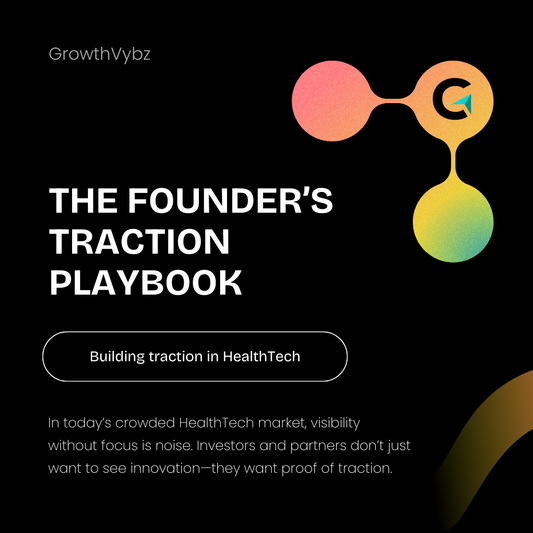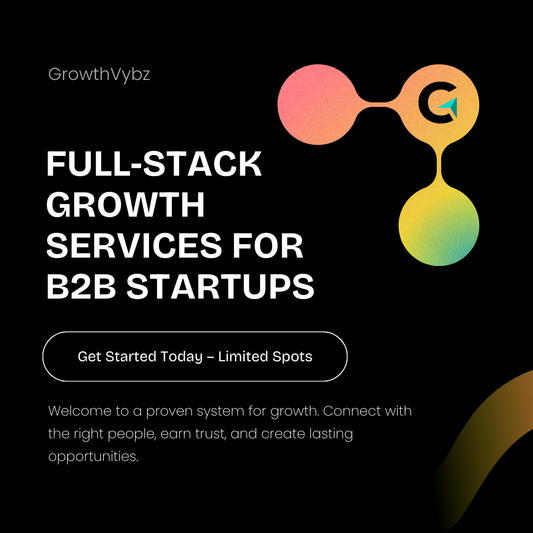At GrowthVybz, we mapped the first four phases of the Healthcare Supply Chain Resilience Process — a system startups, corporates, and investors must understand to survive the next shock.

Phase 1 (Week 1–2): Forecast & Predictive Tools
Why it matters: Most shortages don’t start with production failure — they start with missed signals. Predictive analytics and AI can spot demand surges before shelves run empty.
Companies solving it:
-
LeanTaaS – hospital demand forecasting for beds, meds, and staffing.
-
Kit Check – RFID-enabled drug tracking and predictive pharmacy analytics.
-
Protenus – monitors hospital data to prevent diversion and anticipate shortages.
-
Sensyne Health (UK) – real-world data to forecast demand spikes.
-
Palantir (NHS use) – models national-level shortages across England.
-
GHX (Global Healthcare Exchange) – procurement and predictive inventory.
-
SAS Health Analytics – analytics tools for healthcare demand variation.
-
IBM Watson Health – AI modules for hospital demand and supply planning.
-
Owkin (FR) – disease-pattern AI to predict future drug demand.
-
Health Catalyst – hospital analytics including supply usage.
-
Betr Remedies (EU pilot) – generic supplier using AI-driven forecasts.
-
LogiPharma Analytics Hub – pharma supply chain data aggregation.
Phase 2 (Week 3–4): Production & Local Manufacturing
Why it matters: Over 80% of EU APIs still come from China and India. Local and diversified production ensures resilience against geopolitical shocks.
Companies solving it:
-
Civica Rx (EU collaboration) – nonprofit producing essential generics to reduce dependence.
-
Neurostic (PK medtech) – low-cost prosthetics and devices proving scalable local manufacturing.
-
BrightGene – biosimilars and APIs with European partners.
-
Polpharma (PL) – Poland’s leading generic drug manufacturer.
-
Stada (DE) – German-based generic and specialty drug supplier.
-
Novartis LocalOps – repurposes EU facilities for essential medicine production.
-
Sanofi CEPiA – French-based API and manufacturing service arm.
-
Rovi (ES) – contract manufacturing of parenterals and biosimilars.
-
Bayer Supply Innovation – investing in localized production units.
-
Lonza (CH) – Swiss biomanufacturing powerhouse with EU hubs.
-
Catalent (EU ops) – biologics and sterile fill-finish across Europe.
-
Recipharm (SE) – contract development and manufacturing in Scandinavia.
Phase 3 (Week 5–6): Logistics & Distribution
Why it matters: Medicines are useless if they don’t arrive on time, especially cold-chain vaccines and oncology products. Disruptions in transport = preventable deaths.
Companies solving it:
-
DHL Life Sciences & Healthcare – global leader in pharma logistics.
-
UPS Healthcare Europe – EU cold chain distribution at scale.
-
Kuehne+Nagel PharmaChain – specialized pharma supply solutions.
-
Zipline – drones for urgent rural med deliveries, expanding in EU pilots.
-
Wingcopter (DE) – German drone startup for vaccine and med delivery.
-
Matternet (CH) – Swiss-based urban healthcare drone logistics.
-
Movianto (EU) – pan-European healthcare distribution company.
-
Envirotainer (SE) – air cargo containers for temperature-sensitive medicines.
-
B Medical Systems (LU) – vaccine and blood storage solutions.
-
Pharma.Aero – global pharma air logistics alliance.
-
Agility Logistics – healthcare-focused supply chain operations.
-
GEODIS Healthcare – French global logistics firm handling pharma distribution.
Phase 4 (Week 7–8): Tracking & Transparency
Why it matters: Counterfeit drugs cost €10 billion annually in Europe and threaten patient safety. Serialization, blockchain, and tracking tech are no longer optional.
Companies solving it:
-
Chronicled – blockchain network for pharma verification.
-
Modum.io (CH) – IoT + blockchain for real-time pharma tracking.
-
TraceLink – EU serialization compliance and pharma traceability.
-
SAP ATTP – serialization management for global supply.
-
Arvato Systems – German compliance and serialization provider.
-
Domino Printing Sciences (UK) – secure pharma packaging and coding.
-
Systech – track-and-trace and anti-counterfeiting solutions.
-
rfxcel (Antares Vision Group) – serialization cloud for EU compliance.
-
Adents (FR) – serialization SaaS platform for pharma.
-
Farmatrust (UK) – blockchain anti-counterfeit pharma supply tracking.
-
GS1 Healthcare – global barcode and supply standards.
-
IBM Blockchain for Pharma – pilots with European drugmakers.
Supply Chain Resilience Calculators
Quickly estimate safety stock, shortage impact, localization breakeven, dual-sourcing mix, cold-chain risk, and serialization ROI—then turn insights into pilots.
Safety Stock & Reorder Point
Shortage Cost Impact
Localization Breakeven
Dual-Sourcing Mix (Cost + Risk)
Cold-Chain Excursion Risk
Serialization / Traceability ROI
Framework for Making the Most of the Healthcare Supply Chain Resilience Ecosystem
Most founders, corporates, and even policymakers approach supply chain resilience in a fragmented way — a tool here, a pilot there. But resilience only emerges when all four phases work as a system.
Here’s how to think about it strategically:
1. Forecast Shortages Early (Phase 1 → Data & AI)
-
Problem: In 2024, antibiotic shortages in Germany lasted weeks because hospitals had no predictive warning systems.
-
Framework Action: Build an early warning system by combining disease forecasts with inventory analytics.
-
Example: LeanTaaS helps U.S. hospitals forecast ICU demand; paired with Kit Check’s RFID systems, a hospital group in Spain could anticipate antibiotic consumption spikes before stockouts.
-
How to leverage: For startups — position predictive tools not as “IT add-ons” but as ROI multipliers (reducing emergency purchasing costs). For corporates — embed these into procurement dashboards.
2. Produce Locally & Diversify Sources (Phase 2 → Manufacturing)
-
Problem: 80% of Europe’s APIs come from Asia. When India restricted exports in 2020, European hospitals faced immediate shortages.
-
Framework Action: Shift from “just-in-time” to “just-in-case” with regional manufacturing nodes.
-
Example: Civica Rx (US nonprofit) is expanding to Europe to manufacture essential generics at cost. Pairing Civica’s model with local champions like Polpharma (PL) or Stada (DE) creates redundancy against shocks.
-
How to leverage: Investors should fund startups with flexible manufacturing (3D printing of medtech, on-demand fill/finish). Startups can pitch corporates on “resilience as a service.”
3. Deliver Reliably Across Borders (Phase 3 → Logistics)
-
Problem: Vaccines sat in warehouses during early 2021 because of bottlenecks in distribution. In rural Eastern Europe, deliveries were delayed by weeks.
-
Framework Action: Build multi-layered logistics — combine global operators with innovative last-mile solutions.
-
Example: DHL Life Sciences moves bulk shipments, while Wingcopter (DE) can handle last-mile deliveries to rural clinics in Bavaria or the Balkans. Movianto’s EU distribution hubs can bridge urban areas.
-
How to leverage: Healthtech startups can integrate logistics APIs directly into patient platforms (e.g., telemedicine apps with medication delivery). Corporates should pilot drones now, not wait until the next crisis.
4. Track Everything, End-to-End (Phase 4 → Transparency)
-
Problem: Counterfeit cancer drugs were found in EU hospitals in 2023, highlighting weak serialization compliance.
-
Framework Action: Implement serialization + blockchain at every handoff: manufacturer → distributor → pharmacy → patient.
-
Example: TraceLink helps pharma meet EU FMD (Falsified Medicines Directive) compliance; Farmatrust (UK) adds blockchain anti-counterfeit verification. Chronicled offers a network where every transaction is auditable.
-
How to leverage: Startups can partner with GS1 Healthcare to build compliance-by-design. Investors should look for blockchain + IoT combos like Modum.io (CH), which monitors temperature AND validates authenticity.
Why This Systemic View Matters
The real resilience advantage comes not from one tool but from connecting all four:
-
Forecast → anticipate demand.
-
Produce → secure diverse supply.
-
Distribute → move it reliably.
-
Track → guarantee authenticity.
Think of it as a closed loop: Forecast informs Production, which shapes Distribution, which is validated by Tracking, which feeds back into Forecasting with new data.
Without this loop, resilience breaks.
Where GrowthVybz Fits In
Most founders or corporates plug into only one phase. They don’t know how to:
-
Position their product inside this 4-phase system.
-
Build partnerships across phases.
-
Pitch resilience to investors in a way that unlocks funding and pilots.
👉 That’s where I come in.
-
I help founders frame their startup inside this system for fundraising & go-to-market.
-
I help investors spot which startups complete missing links in the loop.
-
I help corporates & hospitals design multi-phase pilots that reduce cost and risk.
Think of GrowthVybz as the missing systems integrator between great startups and real-world adoption.








